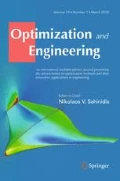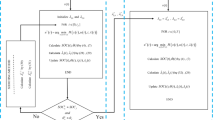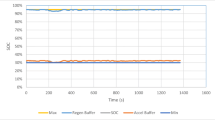Abstract
In Plug-in hybrid electric vehicles (PHEVs) typically combine several power sources, which are coordinated by means of an optimal energy management strategy. When considering the so-called blended mode, in which the engine is regularly used over a trip, the shape of battery state-of-charge (SoC) trajectory over travelled distance is of particular importance for achieving minimum fuel consumption. The paper deals with in-depth analysis of optimal SoC trajectories obtained by off-line control variable optimization of a PHEV-type city bus given in parallel (P2) powertrain configuration. The optimization is conducted by using a dynamic programming-based optimization algorithm for a wide range of driving cycles and operating scenarios. It is found that, as opposed to usually assumed linear-like near-optimal shape, the SoC vs. travelled distance trajectory can take on significantly different optimal shapes for non-zero road grade profiles or driving cycle with relatively long distance. The emphasis is on analyzing root causes for such behavior and its implications to fuel consumption.














Similar content being viewed by others
References
Ambuhl D, Guzzella L (2009) Predictive reference signal generator for hybrid electric vehicles. IEEE Trans Veh Technol 58:4730–4740
Bellman RE, Dreyfus SE (1962) Applied dynamic programming; princeton university press: princeton. NJ, USA
Cipek M, Pavković D, Petrić J (2013) A control-oriented simulation model of a power-split hybrid electric vehicle. Appl Energy 101:121–133
Cipek M, Škugor B, Čorić M, Kasać J, Deur J (2016) Control variable optimisation for an extended range electric vehicle. Int J Powertrains 5:30
Delprat S, Hofman T, Paganelli S (2017) Hybrid vehicle energy management: singular optimal control. IEEE Trans Veh Technol 66(11):9654–9666
Gaikwad T, Asher Z, Liu K, Huang M, Kolmanovsky I (2019) Vehicle velocity prediction and energy management strategy Part 2: integration of machine learning vehicle velocity prediction with optimal energy management to improve fuel economy; SAE Technical Paper 2019–01–1212
Guzzella L, Sciaretta A (2007) Vehicle propulsion systems, 2nd edn. Springer, Germany
Kim N, Cha S, Peng H (2011) Optimal control of hybrid electric vehicles based on Pontryagin’s minimum principle. IEEE Trans Control Syst Technol 19(5):1279–1287
Larsson V, Johannesson Mårdh L, Egardt B, Karlsson S (2014) Commuter route optimized energy management of hybrid electric vehicles. IEEE Trans Intell Transp Syst 15(3):1145–1154
Onori S, Tribioli L (2015) Adaptive Pontryagin’s Minimum principle supervisory controller design for the plug-in hybrid GM Chevrolet Volt. Appl Energy 147:224–234
Schmid R, Buerger J, Bajcinca N (2021) Energy management strategy for plug-in-hybrid electric vehicles based on predictive PMP. IEEE Trans Control Syst Technol. https://doi.org/10.1109/TCST.2020.3048129
Škugor B, Hrgetić M, Deur J (2015) GPS measurement-based road grade reconstruction with application to electric vehicle simulation and analysis. In Proceedings of the 11th Conference on Sustainable Development of Energy, Water and Environment Systems (SDEWES 2015), Dubrovnik, Croatia, 27 September–2 October
Škugor B, Soldo J, Deur J (2019) Analysis of optimal battery state-of-charge trajectory for blended mode of plug-in hybrid electric vehicle. World Electr Veh J 10(4):75
Soldo J, Škugor B, Deur J (2019) Synthesis of optimal battery state-of-charge trajectory for blended mode of plug-in hybrid electric vehicles in the presence of low-emission zones and varying road grades. Energies 12:4296
Soldo J, Škugor B, Deur J (2020) Optimal energy management and shift scheduling control of a parallel plug-in hybrid electric vehicle. Int. J. Powertrains 9(3):240
Soldo J, Škugor B, Deur J (2021) Online synthesis of optimal battery state-of-charge reference trajectory for a plug-in hybrid electric city bus. Energies 14(11):3168
Staunton RH, Ayers CW, Marlino LD, Chiasson JN, Burress BA (2005) Evaluation of 2004 Toyota prius hybrid electric drive system; oak ridge national laboratory (ORNL): Oak Ridge. TN, USA
Taghavipour A, Moghadasi S (2021) A real-time nonlinear CRPE predictive PHEV energy management system design and HIL evaluation. IEEE Trans Veh Technol 70(1):49–58
VOLVO 7900 ELECTRIC HYBRID SPECIFICATIONS. Available online: https://www.volvobuses.co.uk/en-gb/our-offering/buses/volvo-7900-electric-hybrid/specifications.html (accessed on 22 May 2021)
Xie S, Hu X, Xin Z, Brighton J (2019) Pontryagin’s Minimum Principle based model predictive control of energy management for a plug-in hybrid electric bus. Appl Energy 236:893–905
Yu H, Kuang M, McGee R (2014) Trip-oriented energy management control strategy for plug-in hybrid electric vehicles. IEEE Trans Control Syst Technol 22:1323–1336
Yuan Z, Teng L, Fengchun S, Peng H (2013) Comparative study of dynamic programming and pontryagin’s minimum principle on energy management for a parallel hybrid electric vehicle. Energies 6(4):2305–2318
Zhang F, Xi J, Langari R (2017) Real-time energy management strategy based on velocity forecasts using V2V and V2I communications. IEEE Trans Intell Transp Syst 18(2):416–430
Zhang F, Hu X, Langari R, Wang L, Cui Y, Peng H (2021) Adaptive energy management in automated hybrid electric vehicles with flexible torque request. Energy 214:118873
Acknowledgements
It is gratefully acknowledged that this work has been supported by the Croatian Science Foundation under the project No. IP-2018-01-8323 (Project Acronym: ACHIEVE, web site: http://achieve.fsb.hr/).
Author information
Authors and Affiliations
Corresponding author
Additional information
Publisher's Note
Springer Nature remains neutral with regard to jurisdictional claims in published maps and institutional affiliations.
Appendix 1: PHEV model parameters
Appendix 1: PHEV model parameters
The PHEV model parameters are given as follows: final drive ratio io = 4.72, effective tire radius rw = 0.481 m, rolling resistance factor R0 = 0.012, vehicle mass Mv = 12,635 kg, air density rair = 1.225 g/m3, frontal vehicle surface Af = 7.52 m2, vehicle aerodynamical drag factor Cd = 0.7, battery charge capacity Qmax = 30 Ah. The transmission gear ratios are listed in Table
4.
Rights and permissions
About this article
Cite this article
Soldo, J., Škugor, B. & Deur, J. Analysis of optimal battery state-of-charge trajectory patterns for blended mode of a parallel plug-in hybrid electric vehicle and a wide range of driving conditions. Optim Eng 22, 1955–1977 (2021). https://doi.org/10.1007/s11081-021-09656-6
Received:
Revised:
Accepted:
Published:
Issue Date:
DOI: https://doi.org/10.1007/s11081-021-09656-6




